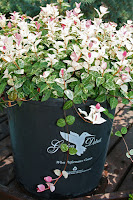 |
| The Rising Sun® Redbud PP21451 |
Awards by horticultural societies help gardeners and landscapers make informed choices about plants. The societies run tests and then acknowledge the best of the best performers. Extensive trials take place before these awards are bestowed on old favorites or new plant introductions.
A familiar example is the annual All-American Rose Selection Winners must embody all of the characteristics today’s homeowners desire in a garden plant. Each winner excelled in a 2-year trial program where it was judged on disease resistance to flower production, color and fragrance.
Another
plant award is the American Hemerocallis Society’s Stout Silver Medal of Honor.
This is the highest award a daylily cultivar can receive and is given in memory
of Dr. Arlos Burdette Stout, the father of modern daylily breeding in North
America. Winners are great performers.
The Royal Horticultural Society’s Award of Garden Merit (AGM), an honor that is well-known and transcends national boundaries. Judging committees from the RHS bestow the award to only the best performers.
Daffodils
have their own award; the John and Gertrude Wister Award from the AmericanDaffodil Society emphasize garden performance with long lasting blooms, clean
color, sunfast, vigorous foliage, disease resistant, and more.
 |
| Gold Medal Plant Award, PHS |
Gold Medal Plant Award Program, Pennsylvania Horticultural Society
Since 1978 the prestigious Gold Medal Plant Award Program of the Pennsylvania Horticulture Society has recognized trees, shrubs and woody vines of outstanding merit. Noted nurseryman Dr. J. Franklin Styler inaugurated this award to showcase superior woody plants for homeowners and landscapers. These woodies are evaluated for their superb eye-appeal, performance and hardiness. People know they can rely on winners for ease of growing, resistance to disease, beauty in many seasons and hardiness in USDA Hardiness Zones 6 - 7 (encompassing Pennsylvania). Garden Debut(R) is pleased to announce The Rising Sun® Redbud PP21451 has been awarded the 2012 Gold Medal from the PHS! This honor recognizes beautiful, reliable and exceptional plants.
 |
| Tangerine to apricot new foliage |
The PHS website states: "Cercis canadensis The Rising Sun(R) Redbud PP21451 is a novel addition to the native eastern redbud roundup. Small but showy rosy orchid flowers climb the naked branches in early spring attracting bees and butterflies. The distinctive bark is smooth tan with a yellowish cast. Emerging heart-shaped foliage is brilliant tangerine to apricot and reputed to hold its color well into fall, surpassing other gold leaved redbuds. Heat tolerance, drought tolerance and cold hardiness are other desirable attributes."
Gardeners and landscapers can purchase The Rising Sun(R) Redbud PP21451 with complete confidence in its performance every time. Another of the Great New Plants(TM) from Garden Debut(R). .



















.jpg)

